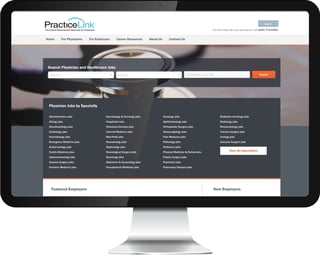 The health care industry is one of the most challenging industries for recruiters—a fact of which physician recruiters are well aware. The short supply and high demand of physicians is a major issue—especially in certain specialties.
The health care industry is one of the most challenging industries for recruiters—a fact of which physician recruiters are well aware. The short supply and high demand of physicians is a major issue—especially in certain specialties.
To recruit those physicians, in-house recruiters need to employ the right strategies at the right time—then prove the effectiveness of their tools to hospital administration.
So how do physician recruiters prove Return On Investment (ROI) from a physician recruitment tool?
Outline what’s at stake
Robin Schiffer, FASPR, director of physician recruitment and physician relations at OhioHealth Mansfield and Shelby Hospitals, mentions that loss of revenue, possible limited patient access and patient satisfaction could all be negatively impacted if it takes longer to hire a physician than planned.
“You could see a drop in referrals depending on the specialty,” Schiffer says. “Finally, a potential loss of certification: for example, a Level II trauma designation.”
Kelley Hekowczyk, MBA, director of physician recruitment and credentialing of UC Health Medical Group, says the absence of a physician in need has far-reaching negative possibilities.
“We could ultimately lose market share for the community that leads to revenue for the organization,” she says. “Without revenue, we are unable to invest in the facility with new equipment, appropriate staffing, etc. We are also at risk to lose additional physicians who may become frustrated with a higher burden for call, hours, etc. This affects provider satisfaction as well as patient and employee satisfaction. They are all related and dependent on one another.”
Lost revenue is also a possibility if physician recruitment departments don't have the tools they need to do their jobs effectively and efficiently.
The latest annual Benchmarking Survey from the Association of Staff Physician Recruiters (ASPR) reports that it takes an average of 175 days to fill a physician opening. According to The Missing Physician, that represents $4,275 in lost revenue per day of vacancy—or $748,125 lost over the course of an average search.
Document the need for recruitment marketing
“Lay out all of your sourcing tools in a document,” recommends Hekowczyk. “Pick out your toughest specialty and research how many are practicing in that specialty currently and how many are being trained/graduate each year. Add to this document that each resident/fellow receives five to seven solicitations for jobs/day. Be compelling in writing a case that depicts that if your health care system isn’t one of those who puts itself in front of physicians on frequent basis, you will be easily forgotten.”
The magic happens when the data tells a story.
For example, Hekowczyk lays out the cost of a PracticeLink account divided by the number of physicians she is able to recruit each year based on responses to the jobs she has posted there. That number helps illustrate the return on investment related to other options.
“This is much less than what multiple ads would have cost in leading journals ($1,000 plus/ad) or by paying a recruitment finders fee ($25,000 average fee) or attending a professional conference ($5,000 to $7,000),” Hekowczyk says of the ROI she sees from PracticeLink. “These numbers are non-specific because each specialty is so different, but gives the general idea.”
Communicate the tools you need
Physician recruiters know the right tool is a critical part of the overall strategy to recruit physician candidates—but you may need to convince your CEO.
Laura Screeney, FASPR, director of physician recruitment at New York-Presbyterian, says “It is the responsibility of a physician recruitment leader to be up-to-date on the physician recruitment market (local and national), benchmarks, budget, community needs, etc.” She recommends looking into ASPR as a resource.
Another valuable physician recruitment tool is data.
“You have to have data on how long is the average time to fill a position, cost, etc.,” Schiffer says. “The recruitment firms are very costly. You need to do an analysis on an in-house recruiter versus recruitment firms, costs as well as benefits.”
Data also plays a role in how Luanne Ramsey, director of talent acquisition for CFG Health Network, secures support for her physician recruitment tools.
“Look at the ROI from other health care companies who have used the tools and the return on their health care investment,” she says. “How many hires did we get when we employed a certain tool? We track all of that so we can speak to that. We can show what our competitors are doing. We don’t want to be cookie cutter. We need to do some things that are different. We can say, ‘Here are the things we need to be doing, here are the tools that can help us, and here’s how they’ve helped others.”








